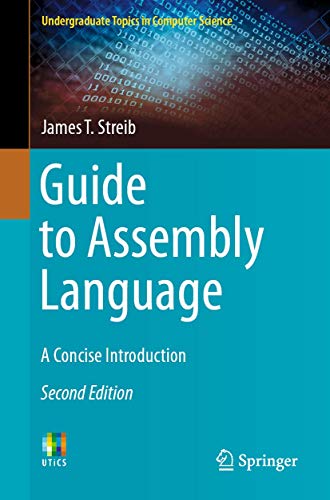
Synopsis
This concise guide is designed to enable the reader to learn how to program in assembly language as quickly as possible. Through a hands-on programming approach, readers will also learn about the architecture of the Intel processor, and the relationship between high-level and low-level languages.
This updated second edition has been expanded with additional exercises, and enhanced with new material on floating-point numbers and 64-bit processing.
Topics and features: provides guidance on simplified register usage, simplified input/output using C-like statements, and the use of high-level control structures; describes the implementation of control structures, without the use of high-level structures, and often with related C program code; illustrates concepts with one or more complete program; presents review summaries in each chapter, together with a variety of exercises, from short-answer questions to programming assignments; covers selection and iteration structures, logic,shift, arithmetic shift, rotate, and stack instructions, procedures and macros, arrays, and strings; includes an introduction to floating-point instructions and 64-bit processing; examines machine language from a discovery perspective, introducing the principles of computer organization.A must-have resource for undergraduate students seeking to learn the fundamentals necessary to begin writing logically correct programs in a minimal amount of time, this work will serve as an ideal textbook for an assembly language course, or as a supplementary text for courses on computer organization and architecture. The presentation assumes prior knowledge of the basics of programming in a high-level language such as C, C++, or Java.
Les informations fournies dans la section « Synopsis » peuvent faire référence à une autre édition de ce titre.
À propos de l?auteur
Dr. James T. Streib is Professor Emeritus of Computer Science at Illinois College, Jacksonville, IL, USA. His other publications include the Springer textbooks Guide to Data Structures and Guide to Java.
Les informations fournies dans la section « A propos du livre » peuvent faire référence à une autre édition de ce titre.
Résultats de recherche pour Guide to Assembly Language: A Concise Introduction
Guide to Assembly Language: A Concise Introduction (Undergraduate Topics in Computer Science)
Vendeur : BooksRun, Philadelphia, PA, Etats-Unis
Paperback. Etat : Very Good. Second Edition 2020. It's a well-cared-for item that has seen limited use. The item may show minor signs of wear. All the text is legible, with all pages included. It may have slight markings and/or highlighting. N° de réf. du vendeur 3030356388-8-1
Acheter D'occasion
Quantité disponible : 1 disponible(s)
Guide to Assembly Language: A Concise Introduction (Undergraduate Topics in Computer Science)
Vendeur : HPB-Red, Dallas, TX, Etats-Unis
paperback. Etat : Good. Connecting readers with great books since 1972! Used textbooks may not include companion materials such as access codes, etc. May have some wear or writing/highlighting. We ship orders daily and Customer Service is our top priority! N° de réf. du vendeur S_397184366
Acheter D'occasion
Quantité disponible : 1 disponible(s)
Guide to Assembly Language : A Concise Introduction
Vendeur : GreatBookPrices, Columbia, MD, Etats-Unis
Etat : New. N° de réf. du vendeur 40538530-n
Acheter neuf
Quantité disponible : Plus de 20 disponibles
Guide to Assembly Language : A Concise Introduction
Vendeur : GreatBookPrices, Columbia, MD, Etats-Unis
Etat : As New. Unread book in perfect condition. N° de réf. du vendeur 40538530
Acheter D'occasion
Quantité disponible : Plus de 20 disponibles
Guide to Assembly Language
Vendeur : Rarewaves.com USA, London, LONDO, Royaume-Uni
Paperback. Etat : New. Second Edition 2020. This concise guide is designed to enable the reader to learn how to program in assembly language as quickly as possible. Through a hands-on programming approach, readers will also learn about the architecture of the Intel processor, and the relationship between high-level and low-level languages.This updated second edition has been expanded with additional exercises, and enhanced with new material on floating-point numbers and 64-bit processing.Topics and features: provides guidance on simpli?ed register usage, simpli?ed input/output using C-like statements, and the use of high-level control structures; describes the implementation of control structures, without the use of high-level structures, and often with related C program code; illustrates concepts with one or more complete program; presents review summaries in each chapter, together with a variety of exercises, from short-answer questions to programming assignments; covers selection and iteration structures, logic,shift, arithmetic shift, rotate, and stack instructions, procedures and macros, arrays, and strings; includes an introduction to floating-point instructions and 64-bit processing; examines machine language from a discovery perspective, introducing the principles of computer organization.A must-have resource for undergraduate students seeking to learn the fundamentals necessary to begin writing logically correct programs in a minimal amount of time, this work will serve as an ideal textbook for an assembly language course, or as a supplementary text for courses on computer organization and architecture. The presentation assumes prior knowledge of the basics of programming in a high-level language such as C, C++, or Java. N° de réf. du vendeur LU-9783030356385
Acheter neuf
Quantité disponible : Plus de 20 disponibles
Guide to Assembly Language: A Concise Introduction (Undergraduate Topics in Computer Science)
Vendeur : Ria Christie Collections, Uxbridge, Royaume-Uni
Etat : New. In. N° de réf. du vendeur ria9783030356385_new
Acheter neuf
Quantité disponible : Plus de 20 disponibles
Guide to Assembly Language : A Concise Introduction
Vendeur : Chiron Media, Wallingford, Royaume-Uni
PF. Etat : New. N° de réf. du vendeur 6666-IUK-9783030356385
Acheter neuf
Quantité disponible : 10 disponible(s)
Guide to Assembly Language : A Concise Introduction
Vendeur : GreatBookPricesUK, Woodford Green, Royaume-Uni
Etat : New. N° de réf. du vendeur 40538530-n
Acheter neuf
Quantité disponible : Plus de 20 disponibles
Guide to Assembly Language : A Concise Introduction
Vendeur : GreatBookPricesUK, Woodford Green, Royaume-Uni
Etat : As New. Unread book in perfect condition. N° de réf. du vendeur 40538530
Acheter D'occasion
Quantité disponible : Plus de 20 disponibles
Guide to Assembly Language
Vendeur : Basi6 International, Irving, TX, Etats-Unis
Etat : Brand New. New. US edition. Expediting shipping for all USA and Europe orders excluding PO Box. Excellent Customer Service. N° de réf. du vendeur ABEOCT25-14468
Acheter neuf
Quantité disponible : 1 disponible(s)
